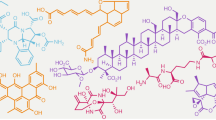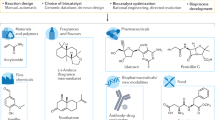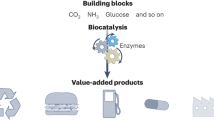Abstract
Natural products continue to fulfill an important role in the development of therapeutic agents. In addition, with the advent of chemical genetics and high-throughput screening platforms, these molecules have become increasingly valuable as tools for interrogating fundamental aspects of biological systems. To access the vast portion of natural-product structural diversity that remains unexploited for these and other applications, genome mining and microbial metagenomic approaches are proving particularly powerful. When these are coupled with recombineering and related genetic tools, large biosynthetic gene clusters that remain intractable or cryptic in the native host can be more efficiently cloned and expressed in a suitable heterologous system. For lead optimization and the further structural diversification of natural-product libraries, combinatorial biosynthetic engineering has also become indispensable. However, our ability to rationally redesign biosynthetic pathways is often limited by our lack of understanding of the structure, dynamics and interplay between the many enzymes involved in complex biosynthetic pathways. Despite this, recent structures of fatty acid synthases should allow a more accurate prediction of the likely architecture of related polyketide synthase and nonribosomal peptide synthetase multienzymes.
This is a preview of subscription content, access via your institution
Access options
Subscribe to this journal
Receive 12 print issues and online access
$259.00 per year
only $21.58 per issue
Buy this article
- Purchase on Springer Link
- Instant access to full article PDF
Prices may be subject to local taxes which are calculated during checkout







Similar content being viewed by others
References
Newman, D.J., Cragg, G.M. & Snader, K.M. Natural products as a source of new drugs over the period 1981–2002. J. Nat. Prod. 66, 1002–1037 (2003).
Spring, D.R. Chemical genetics to chemical genomics: small molecules offer big insights. Chem. Soc. Rev. 34, 472–482 (2005).
Koehn, F.E. & Carter, G.T. The evolving role of natural products in drug discovery. Nature Rev. Drug Discov. 4, 206–220 (2005).
Wilkinson, B. & Bachmann, B.O. Biocatalysis in pharmaceutical preparation and alteration. Curr. Opin. Chem. Biol. 10, 169–176 (2006).
Ro, D.-K. et al. Production of the antimalarial drug precursor artemisinic acid in engineered yeast. Nature 440, 940–943 (2006).
Wang, J. et al. Platensimycin is a selective FabF inhibitor with potent antibiotic properties. Nature 441, 358–361 (2006).
Bentley, S.D. et al. Complete genome sequence of the model actinomycete Streptomyces coelicolor A3(2). Nature 417, 141–147 (2002).
Oliynyk, M. et al. Complete genome sequence of the erythromycin-producing bacterium Saccharopolyspora erythraea NRRL2338. Nat. Biotechnol. 25, 447–453 (2007).
Margulies, M. et al. Genome sequencing in microfabricated high-density picolitre reactors. Nature 437, 376–380 (2005).
Ostash, B.B., Saghatelian, A. & Walker, S. A streamlined metabolic pathway for the biosynthesis of moenomycin A. Chem. Biol. 14, 257–267 (2007).
Song, L. et al. Type III polyketide synthase β-ketoacyl-ACP starter unit and ethylmalonyl-CoA extender unit selectivity discovered by Streptomyces coelicolor genome mining. J. Am. Chem. Soc. 128, 14754–14755 (2006).
McAlpine, J.B. et al. Microbial genomics as a guide to drug discovery and structural elucidation: ECO-02301, a novel antifungal agent, as an example. J. Nat. Prod. 68, 493–496 (2005).
Lautru, S., Deeth, R.J., Bailey, L.M. & Challis, G.L. Discovery of a new peptide product by Streptomyces coelicolor genome mining. Nat. Chem. Biol. 1, 265–269 (2005).
Zazopoulos, E. et al. A genomics-guided approach for discovering and expressing cryptic metabolic pathways. Nat. Biotechnol. 21, 187–190 (2003).
Bachmann, B.O., McAlpine, J.B., Zazopolous, E., Farnet, C.M. & Piraee, M. Farnesyl dibenzodiazopines, their production with microorganisms, and their use as antitumor, antibacterial and antiinflammatory agents. Patent Cooperation Treaty patent WO2004065591 (2004).
Bergmann, S. et al. Genomics-driven discovery of PKS-NRPS hybrid metabolites from Aspergillus nidulans. Nat. Chem. Biol. 3, 213–217 (2007).
Camilli, A. & Bassler, B.L. Bacterial small-molecule signalling pathways. Science 311, 1113–1116 (2006).
Amann, R.I., Ludwig, W. & Schleifer, K.-H. Phylogenetic identification and in situ detection of individual microbial cells without cultivation. Microbiol. Rev. 59, 143–169 (1995).
Brady, S.F. & Clardy, J. Palmitoylputrescine, an antibiotic isolated from the heterologous expression of DNA extracted from bromeliad tank water. J. Nat. Prod. 67, 1283–1286 (2004).
Brady, S.F. & Clardy, J. Cloning and heterologous expression of isocyanide biosynthetic genes from environmental DNA. Angew. Chem. Int. Ed. Engl. 44, 7063–7065 (2005).
Pfeifer, B.A., Admiraal, S.J., Gramajo, H., Cane, D.E. & Khosla, C. Biosynthesis of complex polyketides in a metabolically engineered strain of E. coli. Science 291, 1790–1792 (2001).
Watanabe, K. et al. Total biosynthesis of antitumor nonribosomal peptides in Escherichia coli. Nat. Chem. Biol. 2, 423–428 (2006).
Schmidt, E.W. et al. Patellamide A and C biosynthesis by a microcin-like pathway in Prochloron didemni, the cyanobacterial symbiont of Lissoclinum patella. Proc. Natl. Acad. Sci. USA 102, 7315–7320 (2005).
Long, P.F., Dunlap, W.C., Battershill, C.N. & Jaspars, M. Shotgun cloning and heterologous expression of the patellamide gene cluster as a strategy to achieved sustained metabolite production. ChemBioChem 6, 1760–1765 (2005).
Wenzel, S.C. et al. Heterologous expression of a myxobacterial natural products assembly line in Pseudomonads via Red/ET recombineering. Chem. Biol. 12, 349–356 (2005).
Gross, F. et al. Metabolic engineering of Pseudomonas putida for methylmalonyl-CoA biosynthesis to enable complex heterologous secondary metabolite formation. Chem. Biol. 13, 1253–1264 (2006).
Richardson, S.M., Wheelan, S.J., Yarrington, R.M. & Boeke, J.D. GeneDesign: rapid, automated design of multikilobase synthetic genes. Genome Res. 16, 550–556 (2006).
Kodumal, S.J. et al. Total synthesis of long DNA sequences: synthesis of a contiguous 32-kb polyketide synthase gene cluster. Proc. Natl. Acad. Sci. USA 101, 15573–15578 (2004).
Menzella, H.G. et al. Combinatorial polyketide biosynthesis by de novo design and rearrangement of modular polyketide synthase genes. Nat. Biotechnol. 23, 1171–1176 (2005).
Moss, S.J., Martin, C.J. & Wilkinson, B. Loss of co-linearity by modular polyketide synthases: a mechanism for the evolution of chemical diversity. Nat. Prod. Rep. 21, 575–593 (2004).
Heathcote, M.L., Staunton, J. & Leadlay, P.F. Role of type II thioesterases: evidence for removal of short acyl chains produced by aberrant decarboxylation of chain extender units. Chem. Biol. 8, 207–220 (2001).
Yeh, E., Kohli, R.M., Bruner, S.D. & Walsh, C.T. Type II thioesterase restores activity of a NRPS module stalled with an aminoacyl-S-enzyme that cannot be elongated. ChemBioChem 5, 1290–1293 (2004).
Uguru, G.C. et al. Active-site modifications of adenylation domains lead to hydrolysis of upstream nonribosomal peptidyl thioester intermediates. J. Am. Chem. Soc. 126, 5032–5033 (2004).
Arnold, F.H. Fancy footwork in the sequence-space shuffle. Nat. Biotechnol. 24, 328–330 (2006).
Yoshikuni, Y., Ferrin, T.E. & Keasling, J.D. Designed divergent evolution of enzyme function. Nature 440, 1078–1082 (2006).
Stachelhaus, T., Schneider, A. & Maraheil, M.A. Rational design of peptide antibiotics by targeted replacement of bacterial and fungal domains. Science 269, 69–72 (1995).
Cortés, J. et al. Repositioning of a domain in a modular polyketide synthase to promote specific chain length cleavage. Science 268, 1487–1489 (1995).
Donadio, S., Staver, M.J., McAlpine, J.B., Swanson, S.J. & Katz, L. Modular organization of genes required for complex polyketide biosynthesis. Science 252, 675–679 (1991).
Maier, T., Jenni, S. & Ban, N. Architecture of a mammalian fatty acid synthase at 4.5Å resolution. Science 311, 1258–1262 (2006).
Jenni, S., Leibundgut, M., Maier, T. & Ban, N. Architecture of a fungal fatty acid synthase at 5 Å resolution. Science 311, 1263–1267 (2006).
Tang, Y., Kim, C.-Y., Mathews, I.I., Cane, D.E. & Khosla, C. The 2.7-Å crystal structure of a 194-kDa homodimeric fragment of the 6-deoxyerythronolide B synthase. Proc. Natl. Acad. Sci. USA 103, 11124–11129 (2006).
Jenni, S., Leibundgut, M., Boehringer, D., Frick, C. & Ban, N. Structural basis for substrate delivery by acyl carrier protein in the yeast fatty acid synthase. Science 316, 288–290 (2007).
Weissman, K.J. The structural basis for docking in modular polyketide biosynthesis. ChemBioChem 7, 485–494 (2006).
Hahn, M. & Stachelhaus, T. Harnessing the potential of communication-mediating domains for the biocombinatorial synthesis of nonribosomal peptides. Proc. Natl. Acad. Sci. USA 103, 275–280 (2006).
Koglin, A. et al. Conformational switches modulate protein interactions in peptide antibiotic synthetases. Science 312, 273–276 (2006).
Qiao, C., Wilson, D.J., Bennett, E.M. & Aldrich, C.C. A Mechanism-based aryl carrier protein/thiolation domain affinity probe. J. Am. Chem Soc. 129, 6350–6351 (2007).
Worthington, A.S., Rivera, H., Jr., Torpey, J.W., Alexander, M.D. & Burkart, M.D. Mechanism-based protein cross-linking probes to investigate carrier protein-mediated biosynthesis. ACS Chem. Biol. 1, 687–691 (2006).
Miao, V. et al. Genetic engineering in Streptomyces roseosporus to produce hybrid lipopeptide antibiotics. Chem. Biol. 13, 269–276 (2006).
Nguyen, K.T. et al. Combinatorial biosynthesis of novel antibiotics related to daptomycin. Proc. Natl. Acad. Sci. USA 103, 17462–17467 (2006).
Kopp, F., Grünewald, J., Mahlert, C. & Marahiel, M.A. Chemoenzymatic design of acidic lipopeptide hybrids: new insights into the structure-activity relationship of daptomycin and A54145. Biochemistry 45, 10474–10481 (2006).
Wilcoxen, K.M., Leman, L.J., Weinberger, D.A., Huang, Z-Z. & Ghadiri, M.R. Biomimetic catalysis of intermodular aminoacyl transfer. J. Am. Chem. Soc. 129, 748–749 (2007).
Leman, L.J., Weinberger, D.A., Huang, Z.-Z., Wilcoxen, K.M. & Ghadiri, M.R. Functional and mechanistic analyses of biomimetic aminoacyl transfer reactions in de novo designed coiled coil peptides via rational active site engineering. J. Am. Chem. Soc. 129, 2959–2966 (2007).
Chan, Y.A. et al. Hydroxymalonyl-acyl carrier protein (ACP) and aminomalonyl-ACP are two additional type I polyketide synthase extender units. Proc. Natl. Acad. Sci. USA 103, 14349–14354 (2006).
Reeves, C.D. et al. Alteration of the substrate specificity of a modular polyketide synthase acyltransferase domain through site-directed mutagenesis. Biochemistry 40, 15464–15470 (2001).
Del Vecchio, F. et al. Active-site residue, domain and module swaps in modular polyketide synthases. J. Ind. Microbiol. Biotechnol. 30, 489–494 (2003).
Baerga-Ortiz, A. et al. Directed mutagenesis alters the stereochemistry of catalysis by isolated ketoreductase domains from the erythromycin polyketide synthase. Chem. Biol. 13, 277–285 (2006).
Weist, S. & Sussmuth, R.D. Mutational biosynthesis—a tool for the generation of structural diversity in the biosynthesis of antibiotics. Appl. Microbiol. Biotechnol. 68, 141–150 (2005).
Weissman, K.J. Mutasynthesis—uniting chemistry and genetics for drug discovery. Trends Biotechnol. 25, 139–142 (2007).
Li, S.M. & Heide, L. New aminocoumarin antibiotics from genetically engineered Streptomyces strains. Curr. Med. Chem. 12, 419–427 (2005).
Thibodeaux, C.J., Melancon, C.E. & Liu, H-W. Unusual sugar biosynthesis and natural product glycodiversification. Nature 446, 1008–1016 (2007).
Rodriguez, L. et al. Engineering deoxysugar biosynthetic pathways from antibiotic-producing microorganisms, a tool to produce novel glycosylated bioactive compounds. Chem. Biol. 9, 721–729 (2002).
Hoffmeister, D. et al. Engineered urdamycin glycosyltransferases are broadened and altered in substrate specificity. Chem. Biol. 9, 287–295 (2002).
Zhang, C. et al. Exploiting the reversibility of natural product glycosyltransferase-catalyzed reactions. Science 313, 1291–1294 (2006).
McCoy, E. & O'Connor, S.E. Directed biosynthesis of alkaloid analogs in the medicinal plant Catharanthus roseus. J. Am. Chem. Soc. 128, 14276–14277 (2006).
Chen, S., Galan, M.C., Coltharp, C. & O'Connor, S.E. Redesign of a central enzyme in alkaloid biosynthesis. Chem. Biol. 13, 1137–1141 (2006).
Zhang, Y. et al. Using unnatural protein fusions to engineer resveratrol biosynthesis in yeast and mammalian cells. J. Am. Chem. Soc. 128, 13030–13031 (2006).
Breinbauer, R., Vetter, I.R. & Waldmann, H. From protein domains to drug candidates—natural products as guiding principles in the design and synthesis of compound libraries. Angew. Chem. Int. Ed. 41, 2879–2890 (2002).
Acknowledgements
J.M. thanks the Biotechnology and Biological Sciences Research Council for support of biosynthetic engineering research through grants and studentships (36/B12126 and BB/C503662). S. Moss (Biotica) and M. Gregory (Biotica) are also acknowledged for proofreading the manuscript.
Author information
Authors and Affiliations
Ethics declarations
Competing interests
B.W. works for and has financial interests in Biotica, a drug discovery company that uses biosynthetic engineering technology. J.M. has no competing financial interests.
Rights and permissions
About this article
Cite this article
Wilkinson, B., Micklefield, J. Mining and engineering natural-product biosynthetic pathways. Nat Chem Biol 3, 379–386 (2007). https://doi.org/10.1038/nchembio.2007.7
Published:
Issue Date:
DOI: https://doi.org/10.1038/nchembio.2007.7
This article is cited by
-
Antiplasmodial and trypanocidal activity of violacein and deoxyviolacein produced from synthetic operons
BMC Biotechnology (2018)
-
Gene synthesis allows biologists to source genes from farther away in the tree of life
Nature Communications (2018)
-
Correlating chemical diversity with taxonomic distance for discovery of natural products in myxobacteria
Nature Communications (2018)
-
Current strategies to induce secondary metabolites from microbial biosynthetic cryptic gene clusters
Annals of Microbiology (2018)
-
Thioesterase domain swapping of a linear polyketide tautomycetin with a macrocyclic polyketide pikromycin in Streptomyces sp. CK4412
Journal of Industrial Microbiology and Biotechnology (2016)



